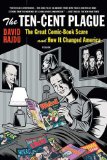The Comics Code Authority is little more than a rubber stamp these days, but in the 1950s, it was a last-ditch attempt to save the industry from a popular backlash against perceived immorality, primarily (but not exclusively) in crime and romance comics. (Though some people thought super-heroes were even worse.) Its restrictions, eventually relaxed during the 1970s, are no doubt responsible for many of the silly story elements of the Silver Age.
Check out the Illustrated Comics Code, which uses Golden Age comics panels to demonstrate just what the original version of the code prohibited. (Be warned: the first image on there is kind of gruesome. And misspells Wertham.)
 On a related note, I recently finished reading David Hajdu’s The Ten-Cent Plague: The Great Comic-Book Scare and How It Changed America. It’s a fascinating look at the early years of the comic book industry, the cultural landscape around it, and how a moral panic (not unlike current controversy over video games — actually, more or less exactly like current controversy over video games) nearly destroyed the industry.
On a related note, I recently finished reading David Hajdu’s The Ten-Cent Plague: The Great Comic-Book Scare and How It Changed America. It’s a fascinating look at the early years of the comic book industry, the cultural landscape around it, and how a moral panic (not unlike current controversy over video games — actually, more or less exactly like current controversy over video games) nearly destroyed the industry.

The funniest part to me? That they even still use it.
.-= Margaret’s latest blog post: Warren Ellis: Totally Jealous of the Six Million Dollar Man =-.
Yeah, when so many books don’t even try to get the CCA seal, I’m surprised DC hasn’t gone the way of Marvel and just switched to a clear rating system.
Exactly. As I try to point out at the Silver Age Comics blog, Silver Age writers were constrained by some reasonable and some nutty restrictions on what their stories could contain. To a large extent, comics in that era were meant to be acceptable to boys from about 8-12 years old. And their mothers.